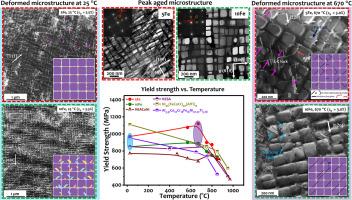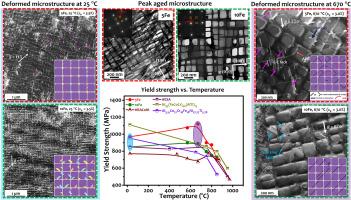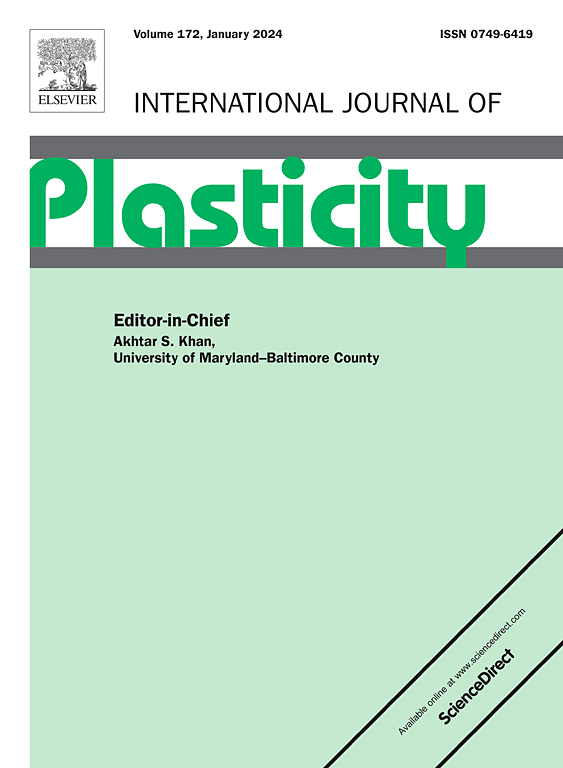CoNiCrFe 高熵合金的塑性变形和强化机制:晶格位点占有率的作用
IF 9.4
1区 材料科学
Q1 ENGINEERING, MECHANICAL
引用次数: 0
摘要
本研究以密度函数理论(DFT)和热力学计算为指导,设计了两种γʹ强化高熵合金,其成分分别为Co34Ni34Cr12Al8Nb3Ti4Fe5和Co31.5Ni31.5Cr12Al8Nb3Ti4Fe10(简称5Fe和10Fe)。这些合金在峰值老化条件下(900 °C,20 小时)表现出相似的沉淀大小、形状、体积分数和 γ/γʹ 晶格错位(∼ 0.56)。耐人寻味的是,尽管这些合金的微观结构相似,但它们在一定温度范围内的屈服强度(YS)演变趋势却不同。5Fe 合金在室温(RT)下显示出更好的强度和延展性组合,YS 和伸长率分别为 970 ± 25 MPa 和 ∼ 18 (%),而 10Fe 合金则为 850 ± 20 MPa 和 ∼ 15 (%)。通过三维原子探针断层扫描进行的沉淀化学分析表明,5Fe 合金中铁原子占据 B 位,而 10Fe 合金中铁原子同时占据 A 位和 B 位。这种位点占据行为使 5Fe 合金具有更高的堆叠断层能(SFE),与 10Fe 合金相比,γʹ 剪切更为困难。同步辐射 X 射线测量进一步证实,与 5Fe 合金中的γʹ析出物相比,γ 基体中的堆叠断层(SF)概率更高。此外,还仔细讨论了变形亚结构演变的作用,以解释高温行为的差异。这些关于高熵合金中合金化学效应的研究结果有助于调整合金的机械性能,并拓宽具有更好高温性能的合金谱。本文章由计算机程序翻译,如有差异,请以英文原文为准。


Plastic deformation and strengthening mechanisms in CoNiCrFe high entropy alloys: The role of lattice site occupancy
The work herein presents the designing of two γʹ strengthened high entropy alloys guided by density function theory (DFT) and thermodynamics calculations with compositions Co34Ni34Cr12Al8Nb3Ti4Fe5 and Co31.5Ni31.5Cr12Al8Nb3Ti4Fe10 (referred as 5Fe and 10Fe). These alloys in the peak aged condition (900 °C for 20 h) exhibit similar precipitates sizes, shapes, volume fractions and γ/γʹ lattice misfit (∼ 0.56). Intriguingly, despite their microstructural similarities, these alloys show different trends in yield strength (YS) evolution over a temperature range. The 5Fe alloy shows a better combination of strength and ductility at room temperature (RT), with YS and elongation of 970 ± 25 MPa, ∼ 18 (%), respectively, in comparison to 850 ± 20 MPa, and ∼ 15(%) in the 10Fe alloy. The precipitate chemistry analyses carried out by 3D atom probe tomography suggest that Fe atoms occupy B-sites in the 5Fe alloy, while it occupies both A and B-sites in the 10Fe alloy. The site occupancy behaviour rendered a higher stacking fault energy (SFE) of the 5Fe alloy, making the γʹ shearing more difficult compared to the 10Fe alloy. The synchrotron X-ray measurements further confirm higher stacking fault (SF) probability in the γ matrix compared to γʹ precipitates in the 5Fe alloy. The role of deformation substructure evolution is also carefully discussed to explain the differences in the high temperature behavior. These results on the effects of alloying chemistry in high entropy alloys enable tuning the mechanical properties of alloys and widening the alloy spectrum with improved high-temperature properties.
求助全文
通过发布文献求助,成功后即可免费获取论文全文。
去求助
来源期刊

International Journal of Plasticity
工程技术-材料科学:综合
CiteScore
15.30
自引率
26.50%
发文量
256
审稿时长
46 days
期刊介绍:
International Journal of Plasticity aims to present original research encompassing all facets of plastic deformation, damage, and fracture behavior in both isotropic and anisotropic solids. This includes exploring the thermodynamics of plasticity and fracture, continuum theory, and macroscopic as well as microscopic phenomena.
Topics of interest span the plastic behavior of single crystals and polycrystalline metals, ceramics, rocks, soils, composites, nanocrystalline and microelectronics materials, shape memory alloys, ferroelectric ceramics, thin films, and polymers. Additionally, the journal covers plasticity aspects of failure and fracture mechanics. Contributions involving significant experimental, numerical, or theoretical advancements that enhance the understanding of the plastic behavior of solids are particularly valued. Papers addressing the modeling of finite nonlinear elastic deformation, bearing similarities to the modeling of plastic deformation, are also welcomed.
 求助内容:
求助内容: 应助结果提醒方式:
应助结果提醒方式:


